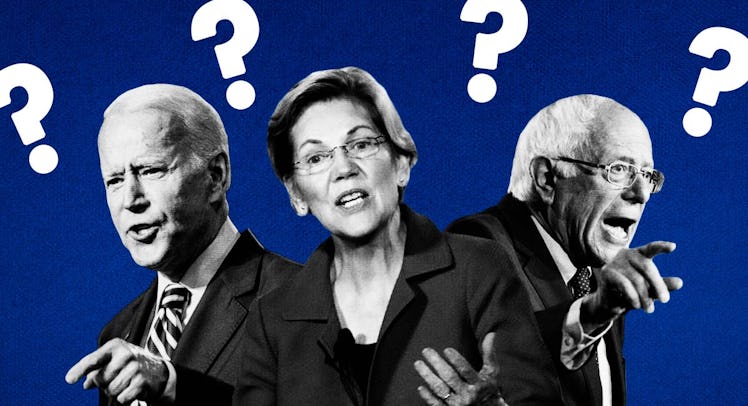The Democratic Party Needs to Talk About Men’s Issues
There are many possible issues for Democratic candidates to discuss, but one set is almost certain to be absent: The myriad problems facing American men.

There are many possible issues for Democratic candidates to discuss, but one set that is almost certain to be absent: the myriad problems facing American men. The very phrase “men’s issues” conjures up images of bitter, angry white guys who fail to realize their roles as oppressors. In the era of #MeToo, even talking about men’s problems can brand one as tone-deaf and sexist.
Also in the era of #MeToo, millions of American men are becoming disconnected from work, children, and family, suffering from poor physical and mental health, and facing issues of addiction and isolation. Yet, most Democrats — who purport to speak up for those who are struggling — seem to go out of their way to avoid these matters. Instead of offering policy solutions, they offer rhetoric, often in the form of concerns about “traditional” beliefs and norms of masculinity. Meanwhile, problems persist. And problems facing men of color continue to be seen only through the lens of race, not gender.
Once upon a time, men and women were equally likely to vote for Democrats and Republicans. That began to change with Ronald Reagan, the idea of a “gender voting gap” emerged, and that gap widened to 24 percentage points in the 2016 presidential election. Since the gap is even larger between white men and women, it might be renamed the “intersectional” gap, after the academically hip phrase meaning that race, gender, class, and other attributes must be examined together. It is widely believed that the 2020 presidential race will hinge on the votes of suburban moms, so it makes sense that Democrats would work hard to shore up if not expand their traditional base. That said, in largely ignoring issues unique to nearly half the population, the miss a massive and critical opportunity.
Democrats are right that we need laws and social norms to try to ensure that women and the LGBT community, as well as African Americans and Latinos, who the party too easily takes for granted, are not discriminated against, are paid equally, can get affordable child care and higher education, have freedom from harassment and violence, and are not the targets of hate speech. But policy is not a zero sum game. By talking about issues that affect women does not mean that the party cannot also talk about men’s needs. Policies can create opportunities for all and it can be articulated in those terms.
During and after the 2016 election, we often heard the simplistic trope that Trump supporters are angry, less-educated white working-class men — the people whom Hillary Clinton, unhelpfully, called “deplorables.” These men on the sidelines of American life also are of all races, places, and classes — among millennials, better-educated late-middle age men, and former prisoners.
But — and it’s a big but — many men are angry (many with good reason), and many white men, as well as men of color, are struggling and hurting. Why?
- The typical man’s wages adjusted for inflation essentially have not risen during the last 45 years. The picture for black men is worse.
- The percentage of the 25- to 54-year-old male population who is working has fallen to a post–World War II low of 88 percent. Including 55- to 64-year-old men, young men who are neither in school nor at work, and America’s 2 million incarcerated men, at least one in five adult men don’t work.
- Mortality rates for men without a college education have risen by about 25 percent, and virtually all of the decline in overall life expectancy during the past two years has been accounted for by white men. Two-thirds of the 660,000 Americans who have died from opioid, heroin, and other drug overdoses are men. Although more than half the murders of women are due to intimate partner violence (read: men), nearly three out of four murder victims are male. The incidence among males of hypertension, high cholesterol, and ADHD has increased significantly since the 1990s, nearly 80 percent of the 47,000 Americans who committed suicide in 2017 were men, and almost all were white men.
- Men have been boorish, violent, and sexist, but many men I interviewed for my book, Man Out: Men on the Sidelines of American Life, rightfully complain that, while feminism has done a lot for women, it has left men confused: If women want equality, why do mothers account for nearly five out of six custodial parents?
- Young white men are more likely than their female counterparts to decamp in their parents’ basements, failing “to launch.”
- The proportion of men living alone increased by 50 percent between 1970 and 2012, in large part a function of men not living with children.
Every political party is clueless, only in a different way. When it comes to gender, while most Republicans seem clueless about the need to make America more fair and safe for women, most Democrats seem to have a big blind spot when it comes to men’s struggles and problems. The Democrats’ problem might be the easier one to solve as the party does not seem to be functionally anti-male. The party just prioritizes more reliable supporters. Again, that makes sense, but also plays right into the opposition’s hands, creating opportunities for President Trump to gain ground with nothing but chest-thumping.
Yes, on average, women face more challenges than men, yet to ignore the difficulties of any population, including men, is shameful — and likely to result in millions of lost male votes.
Andrew L. Yarrow, a former New York Times reporter, U.S. history professor, and policy analyst, discusses these and other issues in his recent book, Man Out: Men on the Sidelines of American Life.
This article was originally published on